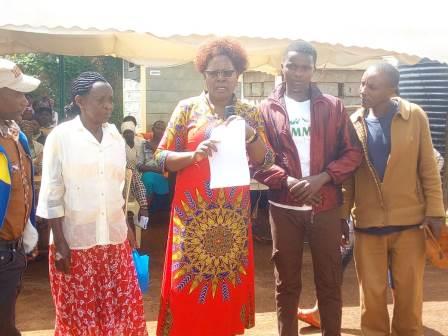Conservationists are warning that species of two rare birds living in Taita Hills risk becoming extinct due to severe loss of habitat and use of non-native trees to rehabilitate degraded areas.
Taita Thrush and Taita Apalis are on the Red List of Critically Endangered Birds by International Union for Conservation of Nature (IUCN). The species are only found in Taita Hills. Critically Endangered category is the final stage before any species is officially declared extinct.
According to IUCN, a global organization that tracks and monitors status of different species of plants and animals, the two birds are dwindling alarmingly. A survey done in August 2018 established that the global population of Taita Apalis stood at between 210 and 430 birds. The numbers of Taita Thrush as at October 2016 was 930.
Mr. John Mlamba, a veteran conservationist, says the fate of the two species hangs by a thread. He adds that rising human population has adversely affected the forests and dense bush where the birds live. This has led to rapid shrinking of habitat which he warns will see the extermination of the feathered beauties.
“Human activities like clearing bush for cultivation has robbed the birds their original homes. If nothing is done, we are witnessing the death of the last species of Apalis and Thrush in the world,” he said.
This grim reality comes barely two years after Sudan, the last known male species of White Rhino died in March 2018 at Ol Pejeta Conservancy in Laikipia County.
There has been efforts by the government and other stakeholder to stem this looming catastrophe. One of the deliberate efforts was the launch of Action Plan for Conservation of Critically Endangered Birds in Taita Hills, Kenya 2015-2020. This is comprehensive report by Kenya Wildlife Service and several Kenyan-based conservation groups as part of seeking interventions to halt the decimation of the two birds in Taita Hills.
The report places the population of Taita Thrush at 1,400; a slightly higher figure than the figures earlier given but their survival remain gravely threatened. The bulk of these surviving birds are in Mbololo Forest which houses 1,060 birds. Some 250 others are in Ngangao forest while Chawia Forest has 35 birds.
However, it is the Taita Apalis that is giving conservationists sleepless night. The report pegs the population of Apalis at between 300 and 600. They are reducing rapidly due to severe habitat loss arising from human activities and predation. Already, Taita Apalis has completely disappeared from two of their traditional habitats in Chawia and Fururu forests.
Rare sightings of these birds are reported in Iyale, Msidunyi and Ngangao forests.
Mr. Mlamba says the biggest threat to the birds’ survival is habitat fragmentation which has confined the birds into tiny colonies separated from each other. This has come about as human settlements crop up in the middle of forests and bushy lands where the birds live. As a result, in-breeding amongst small colonies with a higher male ratio has seen the birds’ population dip sharply.
He says that in early 2006, there were efforts to revive least-cost corridors in farms around Taita Hills. Least-cost corridors was an initiative to encourage farmers to plant indigenous trees in selected places which would link up the fragmented habitats for the birds.
“These corridors would act like bridges which would allow birds from one surviving habitat to move to the next one for mating and hybrid improvement,” he explained. The project, however did not take off due to lack of funds and support from stakeholders.
Mr. Mlamba said that studies by Finland’s University of Helsinki showed that Taita Hills had lost over 90 per cent of its forest cover in the last one century. Sixty per cent of the loss happened in the last 50 years.
He adds that initially, over twenty forests including Chawia, Mbololo, Fururu, Iyale, Msidunyi and Shomoto formed one unbroken continuum of forest cover. This made the birds population thrive. However, settlement in those forests cut off the birds leading to the current situation where they might become extinct.
The 2015-2020 Action Plan report also cites using non-native trees for reforestation as working against the rejuvenation of the birds’ population. As a result, farmers are urged to plant indigenous trees to boost the endangered birds’ numbers.
Mr. Mlamba, who is also the director of Management of Arid Zones and Initiatives for Development Options (MAZIDO) said there was a renewed effort to encourage farmers to plant indigenous trees.
In a program dubbed Vuria Forest Restoration and Livelihood Improvement (Vuforeli) project, his group is working with 1,000 farmers living around the degraded Taita Hills to restore the natural vegetation cover using native trees.
“We are educating farmers on why they should plant indigenous trees. This is the only hope remaining for the birds,” he said.
As part of livelihood improvement, farmers are being encouraged to plant Macadamia trees as an alternative to their preference for non-native trees which they claim are economically beneficial due to timber harvesting.
Nature Kenya, an NGO that deals with conservation of birds, has also joined in the campaign to save the two bird species. Apart from tree planting, the organization has started donating energy efficient jikos to schools to prevent excessive use of firewood which contribute to deforestation.
Mr. Gilbey Obunga, an official with Nature Kenya, says there are plans to give such jikos to households around the remaining forests in Taita Hills to ease the pressure on forests in search of firewood.
“The energy-efficient jikos use very little wood. This means the need for a lot of firewood will go down and our forest will heal as trees will have time to grow,” he said. This, he adds, will be a boost to the dwindling population of the birds.
By Wagema Mwangi
Tuesday, April 15, 2025



